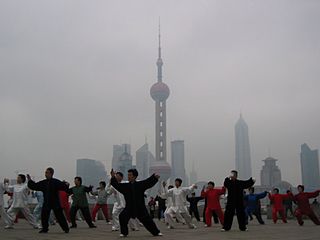
Shaolin Monastery, also known as Shaolin Temple, is a renowned temple recognized as the birthplace of Chan Buddhism and the cradle of Shaolin Kung Fu. It is located at the foot of Wuru Peak of the Songshan mountain range in Dengfeng County, Henan Province, China. The name reflects its location in the ancient grove of Mount Shaoshi, in the hinterland of the Songshan mountains. Mount Song occupied a prominent position among Chinese sacred mountains as early as the 1st century BC, when it was proclaimed one of the Five Holy Peaks. It is located some thirty miles southeast of Luoyang, the former capital of the Northern Wei Dynasty (386–534), and forty-five miles southwest of Zhengzhou, the modern capital of Henan Province.

Shaolin Kung Fu, also called Shaolin Wushu, or Shaolin quan, is one of the oldest, largest, and most famous styles of wushu, or kung fu of Chan Buddhism. It combines Ch'an philosophy and martial arts and originated and was developed in the Shaolin temple in Henan province, Greater China during its 1500-year history. Popular sayings in Chinese folklore related to this practice include "All martial arts under heaven originated from Shaolin" and "Shaolin kung fu is the best under heaven," indicating the influence of Shaolin kung fu among martial arts. The name Shaolin is also used as a brand for the so-called external styles of kung fu. Many styles in southern and northern China use the name Shaolin.

Zhàozhōu Cōngshěn (778–897) was a Chán (Zen) Buddhist master especially known for his "paradoxical statements and strange deeds".

Mount Emei, alternately Mount Omei, is a 3,099-meter-tall (10,167 ft) mountain in Sichuan Province, China, and is the highest of the Four Sacred Buddhist Mountains of China. Mount Emei sits at the western rim of the Sichuan Basin. The mountains west of it are known as Daxiangling. A large surrounding area of countryside is geologically known as the Permian Emeishan Large Igneous Province, a large igneous province generated by the Emeishan Traps volcanic eruptions during the Permian Period.
The Venerable Chi Sim Sim Si is a legendary Chinese martial artist, is said to have been one of the Five Elders, survivors of the destruction of the Shaolin Temple by the Qing Dynasty (1644–1912). He is linked to many southern Chinese martial arts including the five major family styles of Hung, Lau and Choy gar, Lee gar and Mok gar, Ng Ga Kuen/Ng Gar King and Wing Chun.

White Crane Style is a Southern Chinese martial art that originated in Yongchun County, Fujian (福建) province. According to oral tradition, the style was developed by Fang Qiniang, a female martial artist. It is associated with traditional fighting techniques, including long range, but is most similar to close-quarter or hand-to-hand combat. It is most recognizable by the way the fighter imitates a bird's pecking or flapping of wings. While some white crane styles make use of traditional weapons, others have discontinued the use of weaponry.

Nanquan refers to a classification of Chinese martial arts that originated south of the Yangtze River in China around the late Ming dynasty and early Qing dynasty.
Shaolin Monastery or Shaolin Temple is a Buddhist monastery in Henan province, China.

There are hundreds of different styles of Chinese martial arts, each with their own sets of techniques and ideas. The various movements in kung fu, most of which are imitations of the fighting styles of animals, are initiated from one to five basic foot positions: normal upright posture and the four stances called dragon, frog, horse riding, and snake. The concept of martial arts styles appeared from around the Ming dynasty (1368–1644). Before the Ming period, martial skills were commonly differentiated mainly by their lineage. There are common themes among these styles which allow them to be grouped according to generalized "families", "fractions", "class", or "schools" of martial art styles. There are styles that mimic movements from animals, or otherwise refer or allude to animals or mythical beings such as dragons, and others that gather inspiration from various Chinese philosophies or mythologies. Some deeply internal styles tend to focus strongly on practice relating to harnessing of qi energy, while some more-conspicuously external styles tend more to display skills and abilities in competition or exhibition.
Shi Yongxin is the current abbot of the Shaolin Temple. He is the thirteenth successor after Shi Xingzheng. He is the Chairman of the Henan Province Buddhists Association, a representative of the Ninth National People's Congress and also one of the first Chinese monks ever to get an MBA degree.
Matthew Polly is an American author who writes about martial arts. His books include American Shaolin, Tapped Out, and Bruce Lee: A Life.

Nanquan Puyuan was a Chán (Zen) Buddhist master in China during the Tang Dynasty. He was the student and Dharma successor of the Master Mazu Daoyi (709-788).
The Southern Shaolin Monastery or Nan-Shaolin (南少林) is the name of a Buddhist monastery whose existence and location are both disputed although associated ruins have been identified. By tradition, it is considered a source of Nanquan.

Wang Bo is a martial artist, Zen Buddhist monk, Shaolin Kung Fu master, and Shifu of the Shaolin Temple Torrance, located in Torrance, CA, a main branch of the original Shaolin Temple of China. He is the founder of Hungrymonk Yoga.
Huang Junhua is a professional wushu taolu athlete from Macau. He is a two-time world champion and the second ever gold medallist for Macau at the Asian Games.

Nanquan Temple is a Buddhist temple located in Xiangyin County, Hunan, China.
Ng Siu Ching is a former wushu taolu athlete from Hong Kong. She achieved an extensive medal record in international competition, becoming the first taolu athlete to win five gold medals at the World Wushu Championships. Ng also had multiple victories in the Asian Games and the East Asian Games.
He Qiang is a retired professional wushu taolu athlete from China.
Yuen Ka Ying is a retired professional wushu taolu athlete from Hong Kong.









